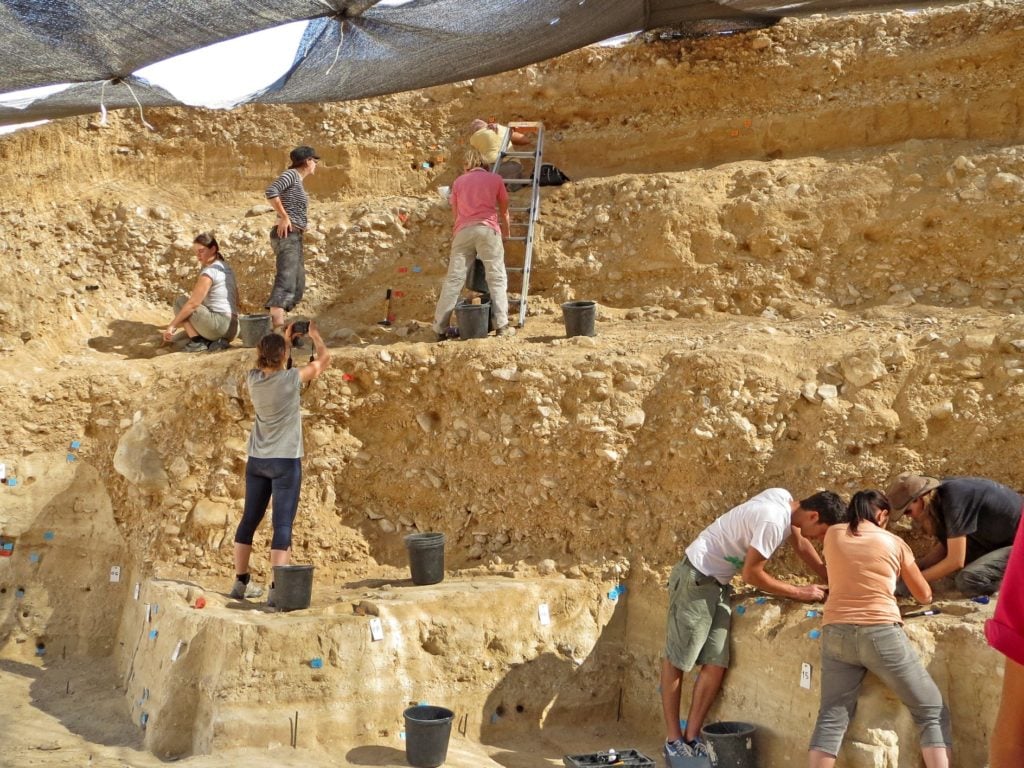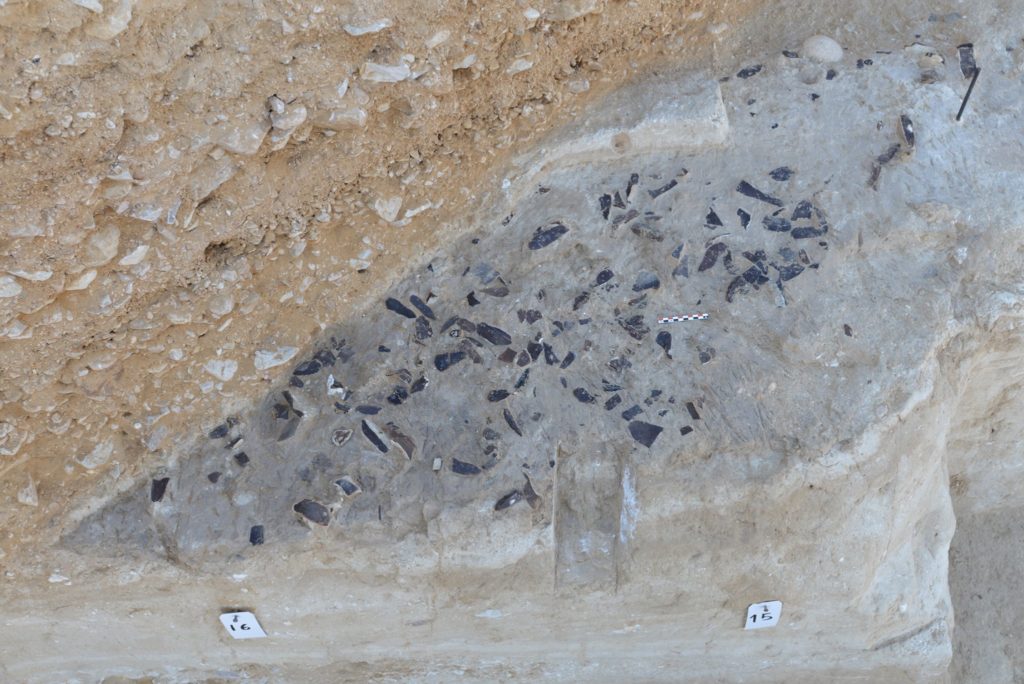
Recent research from an Israeli archaeological dig has proven that modern humans and Neanderthals lived together in the Negev desert some 50,000 years ago. Not only that, but the site they excavated, Boker Tachtit, has now been established as the earliest known migration point from Africa for early Homo sapiens from the Levant.
In the Middle Palaeolithic era, 250,000 to 50,000 years ago, two humanoid species lived in the Old World at the same time: Neanderthal man and modern man (Homo sapiens).

The Neanderthals lived in Europe and Central Asia whereas modern man lived in Africa at that time.
As the Israel Antiquities Authority states regarding the ground-breaking findings, “the Middle East, and the region of Israel in particular, were at the limits of the distribution of these two species and they therefore also contain remnants of the two populations at different times.”
The research undertaken at the Boker Tachtit site in Ein Avdat National Park in Israel’s Negev desert has now provided the first proof of the two cultures’ coexistence there and pinpoints—for the first time ever—the exact time when modern humans left Africa.

A recent reexamination of artifacts from the Boker Tachtit site was the subject of a study published on Monday in the scientific journal Proceedings of the National Academy of Sciences (PNAS).
The dig was led by researchers from the Weizmann Institute of Science and the Max Planck Society, Prof. Elisabetta Boaretto together with Dr. Omry Barzilai of the Israel Antiquities Authority (IAA).
“Boker Tachtit is the first site outside of Africa, which modern man penetrated on his way to the rest of the world, hence the importance of the site, as well as the importance of dating it accurately,” said Dr. Barzilai, the director of excavation at the Boker Tachtit site in the statement.
“The age of the site as dated in the study—50,000 years—indicates that modern man existed in the area of the Negev at the same time as the Neanderthal man, who is known to have lived in it during this period,” he explained.
“There is no doubt that the two species who lived and roamed the Negev were aware of each other’s existence,” Barzilai declared, adding “Our research Boker Tachtit site places an important and unequivocal point of reference on the timeline of human evolution.”
The “recent African origin” theory of human development stipulates that Homo sapiens originated in Africa as early as 270,000 years ago; at different times, humans took either the northern route to Eurasia, passing through the Levant, or several possible southern routes to all the corners of Asia.
Many believe that Homo sapiens even reached Oceania—getting as far as Australia by land at that time.
Scientist believe that DNA research shows the migration of modern humans began from Africa to Asia and Europe and proceeded onward to the rest of the world approximately 60,000 years ago.
The clashing of humans with their “cousins,” the Neanderthals, caused the latter to disappear as a group but at the same time assimilate into the entirety of the modern human population outside Africa.
Boker Tachtit, which is located in Ein Avdat National Park, is known to have served as a key site for tracing this migration out of Africa.
It is now proven to show the transition from a predominantly Neanderthal, prehistoric culture to the beginning of the triumph of modern humans, which occurred during the Middle to Upper Paleolithic era.
This vital turning point in development was marked by monumental technological innovations, including the making of blades and the introduction of standardized tools utilizing bones and antlers.
Anthony Marks, an American researcher who was the first to excavate and publish his findings from the Boker Tachtit site in the early 1980s, stated at the time that the site showed transitional industry from the Middle to the Upper Paleolithic eras.
Based on one single radiocarbon date, he concluded that it dated back to 47,000 years ago.
Other dates obtained from artifacts at the site, however, contradicted dates provided by Marks. The site may also be from 34,000 years ago, making the timing of the tool transition very problematic for researchers.
Boaretto, who heads up D-REAMS, the Dangoor Research Accelerator Mass Spectrometry Laboratory located at the Weizmann Institute, which specializes in advanced archaeological dating methods, explains further.
“If we are to follow this timeline, then the transitional period could have lasted more than 10,000 years, and yet artifacts excavated from northern sites in Israel, Lebanon and even Turkey suggest that the transition occurred much faster,” she says.
“Marks managed to date only a few specimens from Boker Tachtit, owing to the limitations of radiocarbon dating then, and the range of his proposed dates is not consistent with evidence gathered from other—old and new—excavation sites in the region,” Boaretto adds.
“Radiocarbon dating, the method that he used in his study, has evolved tremendously since his time,” she explains.
To finally arrive at some kind of understanding of the site, Boaretto, Barzilai, and their team of researchers performed state of the art dating methods on specimens obtained from Boker Tachtit during the new excavations that they themselves undertook from 2013 to 2015.
These new dating techniques included high-resolution radiocarbon dating of single charcoal pieces found at the site and optically-stimulated luminescence-dating of single grains of quartz sand, performed respectively at the Weizmann Institute and at the Max-Planck Institute.
Boaretto, Barzilai, and their team also took into account detailed studies of the sediments found at Boker Tachtit and employed micro-archaeological methods to understand how the site was initially formed in order to discover information on its chronology.
“We are now able to conclude with greater confidence that the Middle-to-Upper Paleolithic transition was a rather fast-evolving event that began at Boker Tachtit approximately 50-49,000 years ago and ended about 44,000 years ago,” Boaretto declared.
Her team’s new dating allows for a certain overlap between the transition that occurred at Boker Tachtit and that of the “Mediterranean woodland” region, including what is now Lebanon and Turkey, which happened between 49,000 and 46,000 years ago.
Barzilay said “The dating results prove—for the first time in prehistoric research—the hypothesis that there was indeed an overlap in space between the late Mostar culture, identified with Neanderthal man, and the Emirite culture, linked to the emergence of modern man in the Middle East.”
Even with this few thousand years’ overlap of time, the recent analysis shows that Boker Tachtit was the very earliest site for this transition in the Levant. Not only that, but based on the materials found, it also encapsulates evidence from the last time modern humans left on their different journeys out of Africa.
The new dating shows that the early phase at Boker Tachtit also overlaps with the existing Middle Paleolithic culture of the Neanderthals who were already proven to have lived there.
Boaretto and Barzilay conclude “This goes to show that Neanderthals and Homo sapiens in the Negev coexisted and most likely interacted with one another, resulting in not only genetic interbreeding, as is postulated by the ‘recent African origin’ theory, but also in cultural exchange.”
See all the latest news from Greece and the world at Greekreporter.com. Contact our newsroom to report an update or send your story, photos and videos. Follow GR on Google News and subscribe here to our daily email!



